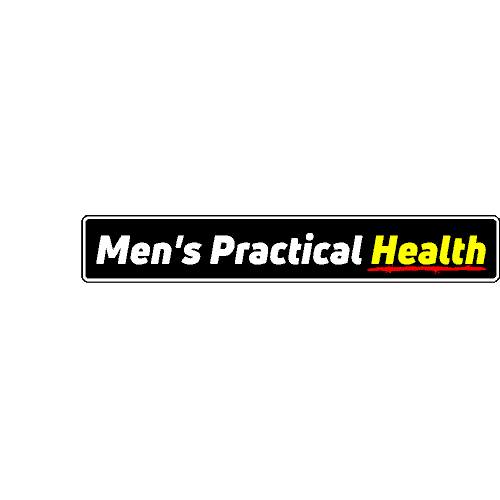There is so much contradictory information about how to muscle building. After recently re-igniting my passion to build muscle, I will share my knowledge …
And the best exercises so you can achieve significant gains.
From Beginner to intermediate …
This awesome guide will help you build larger muscles. It explains everything simply and tells you the best exercises to support muscle growth.
Benefits of Building Muscle Mass

Juggling family, career, and personal time is no mean feat— but the benefits of strong, well-built muscles extend far beyond aesthetics. Enhanced strength bolsters your daily activities, from playing with your kids to lugging grocery bags.
An increased muscle mass elevates your metabolic rate, translating to a more effective calorie burn throughout the day, and can improve your body’s insulin sensitivity, which is critical in warding off diabetes.
Mental fortitude and confidence soar alongside muscle growth; in some cases, it provides a therapeutic outlet for stress. If these advantages haven’t convinced you, consider the long-term investment in your health.
Muscles, much like bone density, deteriorate with age. By laying a robust muscle framework now, you’re shoring up your health for the future.
What Kind of Training Builds Bigger Muscles?
The most effective training method is Hypertrophy training when aiming to build bigger muscles.
This approach focuses on performing exercises with a higher volume. This means more sets and reps— at a moderate intensity.
Hypertrophy training stimulates the muscles to grow larger through cellular changes. This increases the size of the muscle fibres.
While strength and endurance can play a role, hypertrophy training should take priority.
Incorporating a hypertrophy-centric workout plan is crucial for maximising muscle mass.
Also, when building muscle, progressive overload reigns supreme.
So make sure to increase the stress on your body through more weight or decreased rest period.
This principle is the cornerstone of any muscle-building plan.
Your muscles adapt to the increased demands by growing bigger and stronger. To help this growth, aim for a rep range of 8-12. Use a weight that you can lift with good form, and that will make the last few reps challenging.
Compound or Isolation Exercises
Compound movements recruit several muscles in one exercise. This creates functional strength and produces anabolic hormonal responses that encourage muscle growth.
So compound exercises should be at the heart of your workouts to maximise gaining muscle …
as this type of exercise targets the body’s major muscle groups.
This means more calories are burnt during a workout. Also, more muscle fibres receive stimulus, promoting increased muscle growth.
While compound exercises are more effective, isolation exercises provide different benefits.
Isolation exercises are valuable for targeting single muscles. Such as, to address specific imbalances or weaknesses.
As you become more experienced at weightlifting, isolation exercises can be beneficial
Before a compound exercise, you can fatigue a specific muscle.
Another excellent reason for an isolation exercise is to fatigue a specific muscle. This allows you to use less weight during the compound exercise …
Without decreasing the intensity.
The Best Exercises To Build Muscle
So, let’s remove the complexity and get down to the exercises you should include in your workouts.
Barbell Back Squats
The squat is the chief of lower body exercises. Squats work the major leg muscles, quadriceps, hamstrings and glutes.
Deadlifts
The primary muscle targeted in the deadlift is the erector spinae. These muscles run along your spine and are crucial for maintaining proper posture.
Additionally, deadlifts also engage a variety of other muscles throughout the body.
These include:
- Gluteus maximus
- Hamstrings
- Adductor muscles
- Trapezius
- forearm muscles
Like squats, this compound exercise builds muscle due to the wide range of muscles worked
Bench Press
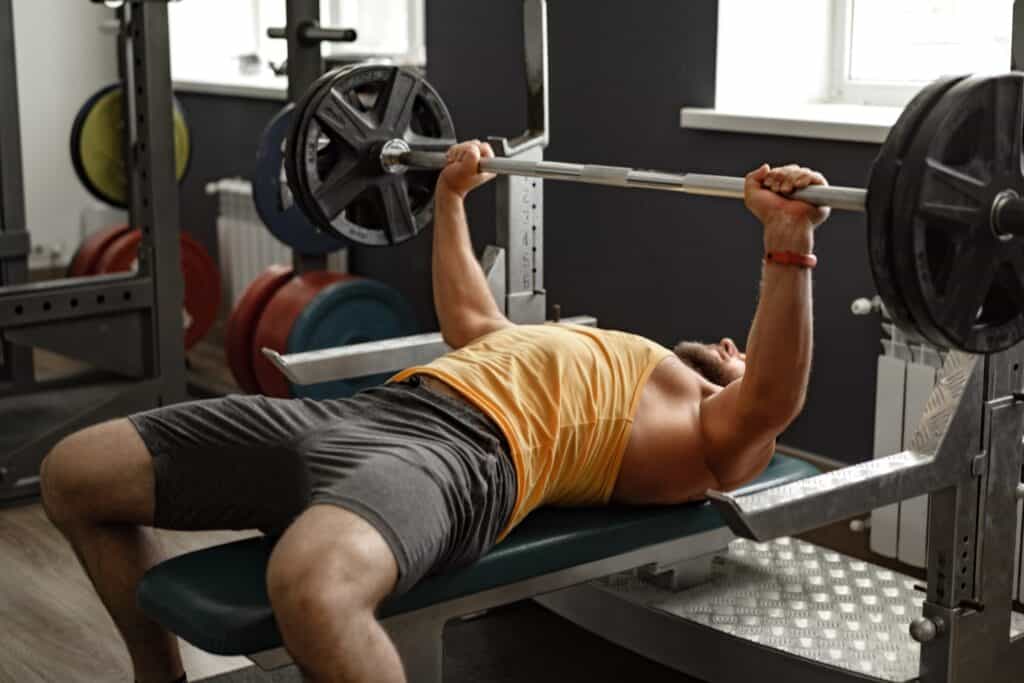
The bench press is fundamental for developing the chest muscles or pecs. It works the pectoralis major’s sternum and clavicular heads.
Having a decent amount of chest muscle is many people’s holy grail.
Yet, the bench press works more than the pec muscles. The synergistic muscles also benefit from this exercise.
These muscles include:
- Triceps
- Deltoids
This means that the bench press is a powerful exercise for gaining mass in the upper body.
A large, well-defined chest is not only aesthetically pleasing …
But it’s also a symbol of strength. This is crucial in pushing and pressing movements across everyday life.
Cable Chest-Fly Exercise
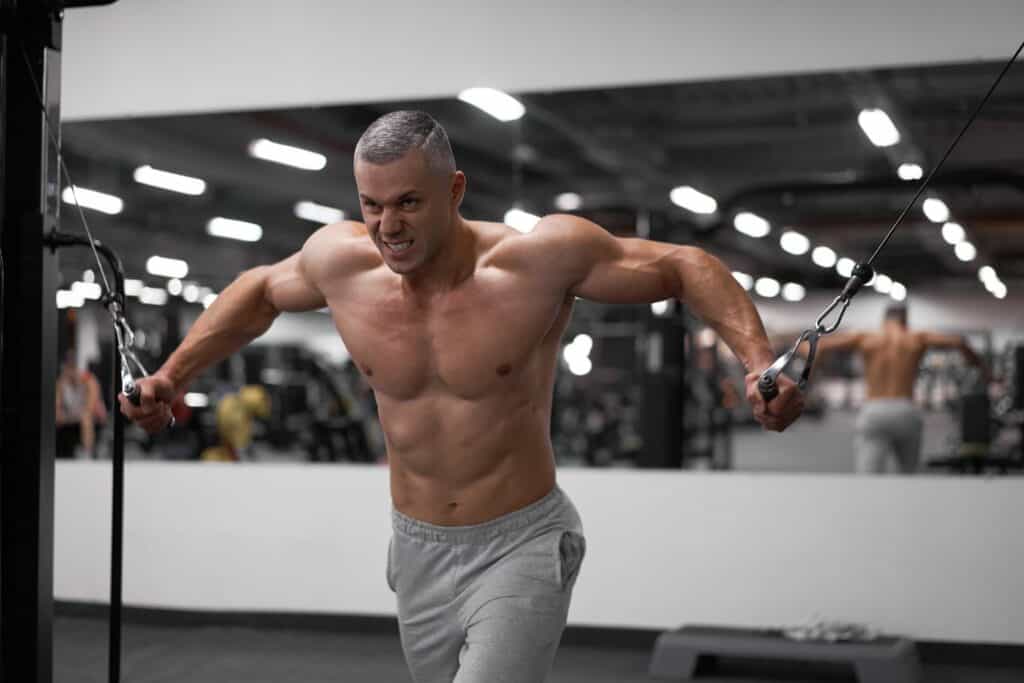
The cable chest fly is an awesome exercise to increase the pectoral muscles. While the dumbbell version is excellent, and I use that as well …
I chose the cable version because of two reasons.
- The constant tension on the muscle
- Being able to cross the hands over at the end of the movement
This exercise enhances the chest’s aesthetic appeal. It defines the line down the centre of the chest and improves the chest width. Its effectiveness lies in stretching the pecs from a more extended range of motion. This leads to increased muscle tear.
Pull-Ups
The pull-up is a powerful exercise to target the large back muscles. This includes:
- Latissimus dorsi, (responsible for the width of the back)
- Trapezius (contributes to the back’s thickness and health)
They also develop:
- The biceps
- The forearms
- The rhomboids
This makes the pull-up an excellent compound movement for the upper body.
Pull-ups often present a challenge, especially for beginners. But as you build up your strength, it can have a massive impact on building those back muscles.
Barbell Bent Over Rows
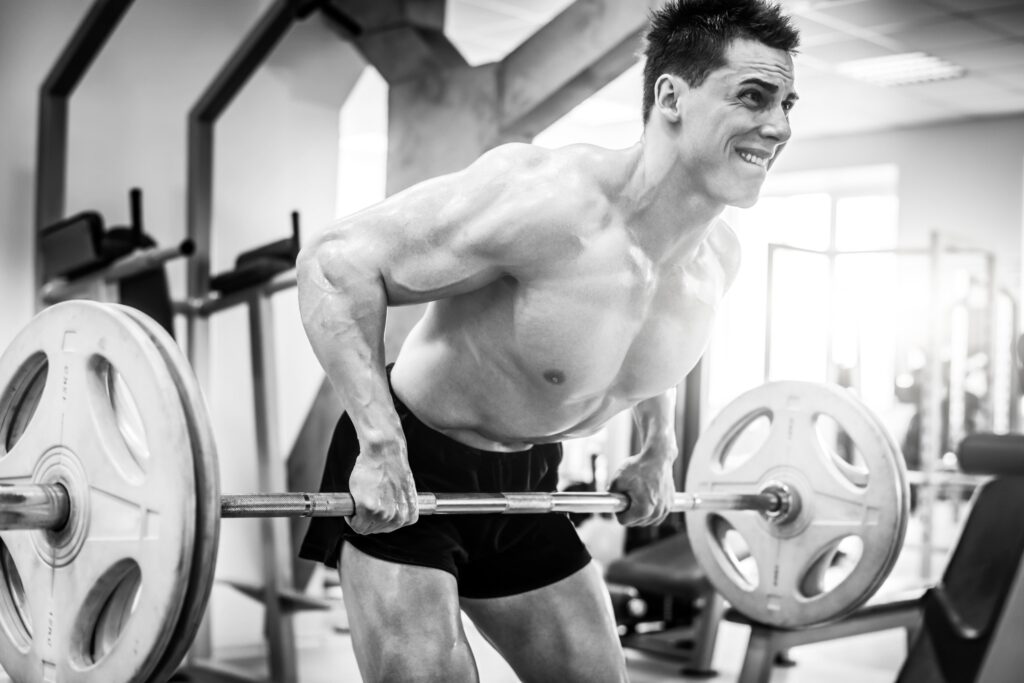
Barbell Bent Over Rows are a potent exercise targeting several key muscle groups, primarily the middle to the upper back.
This includes the latissimus dorsi, rhomboids, and trapezius, which contribute to the thickness and strength of the back.
Also, the posterior deltoids and, to a lesser extent, the biceps and forearms are worked. Making this an excellent all-around exercise for developing a thick, muscular back.
Tricep Pulldowns
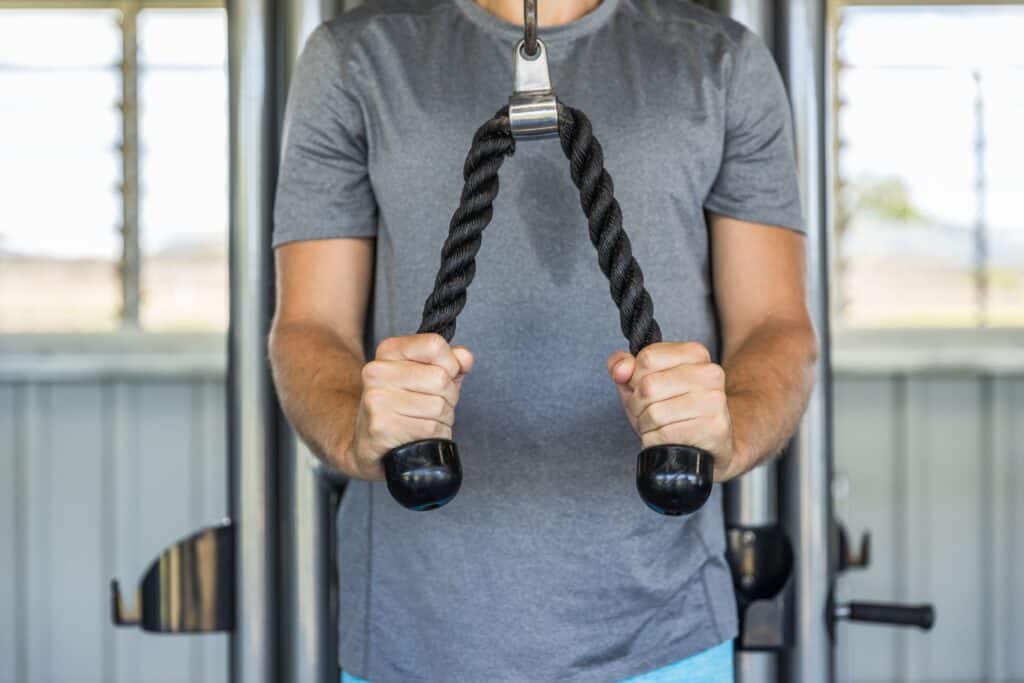
Tricep Pulldowns are a fantastically effective movement for targeting the triceps.
The isolation exercise focuses explicitly on the triceps without the assistance of other muscle groups. Using a cable machine delivers a constant resistance throughout the entire motion, which ensures that the triceps are under continuous tension.
This uninterrupted force stimulates hypertrophy and increases arm definition. The tricep Pulldown is an essential exercise for those looking to increase the size of their triceps.
Bicep Curls

Bicep Curls are a quintessential exercise for anyone aiming to increase the size of their bicep muscles.
They specifically target the biceps brachii, brachialis, and brachioradialis, facilitating concentrated muscle growth.
The beauty of the bicep curl lies in its simplicity and versatility. You can use dumbbells, barbells, or cable, each providing unique benefits.
Other important factors contribute to muscle growth. So, make sure to follow these tips:
- Recovery and Rest: Mending Muscles After The Workout
- Nutrition For Building Muscles
- Muscle-Building Supplements
Recovery and Rest: Mending Muscles After The Workout

While training the muscles is essential, muscle growth happens during recovery.
High-intensity exercises like the ones discussed above cause muscle fibres to break down, but rest encourages them to grow stronger.
In fact, during sleep, the body does most of its repair and growth, so make sure to get enough sleep.
Also, active recovery days that involve light exercise, such as walking, will aid muscle repair.
Be sure to allow at least 48 hours of rest for each muscle group before working it again. Overtraining can lead to stagnation and potential injury, so listen to your body’s cues and adjust your training intensity and rest time accordingly.
Nutrition For Building Muscles
Nutrition is the foundation upon which muscles are built. Before you even set foot in the gym, what you eat can influence your muscle-building success.
You need to be in a caloric surplus. In other words, you need to eat more calories than you burn.
Not eating enough calories will hinder your muscle growth. No matter how hard you work in the gym.
But do not go overboard!
You want to gain muscle, not fat.
And while it is inevitable that you will gain some fat when you eat more calories than your body’s maintenance level …
You want to keep that fat percentage low.
So, increase your calorie intake to 300-500 above your maintenance level, and this will help your muscle-building without adding too much fat.
Also, ensuring you’re appropriately fueled can lead to better performance and energy during your workout.
The Pre-Workout Meal
A balance of protein and carbohydrates 1 – 2 hours before your workout is ideal.
Lean protein sources combined with carbohydrates like rice or sweet potatoes provide sustained energy for your training session.
Avoid high-fat foods, as they can slow digestion and leave you feeling sluggish.
The Power of Post-Workout Nutrition
Post-workout nutrition is critical for recovery. A meal or shake containing fast-digesting protein and simple carbohydrates within 45 minutes of your workout can kickstart recovery.
But don’t panic if that is not possible. Simply consume a decent meal within 2 hours of your workout. This will be enough to replenish your body and help those muscles to grow.
Whey protein is often the go-to for a quick protein source, and adding in some fast-acting carbs like a banana can replenish your glycogen stores.
I have a banana or two with a whey protein shake after a workout and then have a proper meal an hour to an hour and a half later.
Muscle-Building Supplements
Supplements can top up any insufficient nutrients in your diet but are not a substitute for whole foods.
Some supplements have sufficient evidence supporting their role in muscle growth, while the jury is still out on others.
Protein Powder
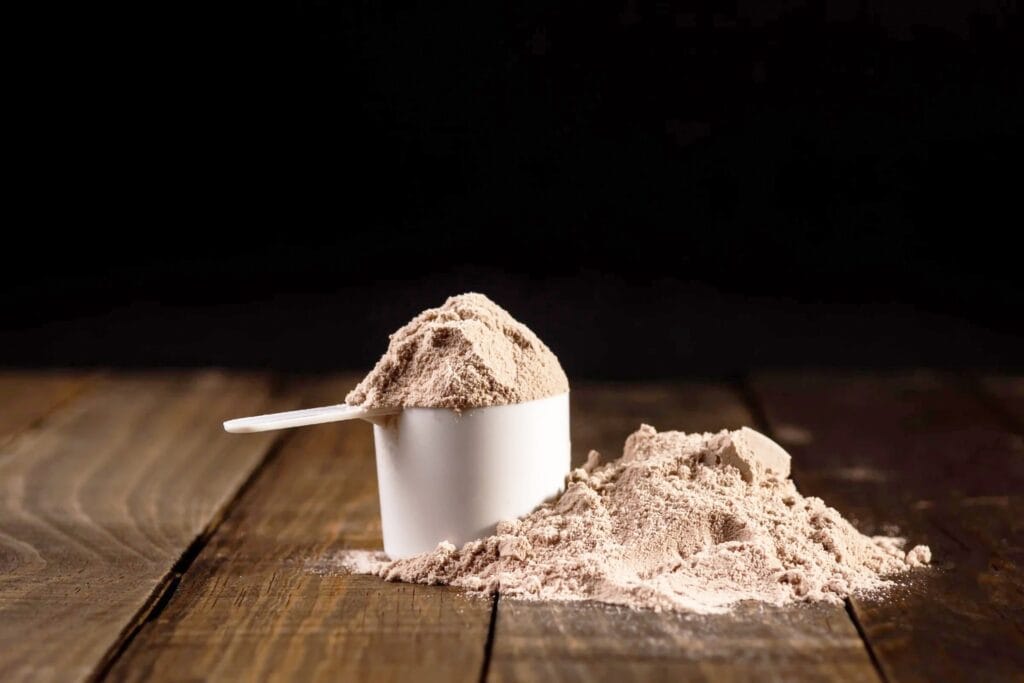
Whey and casein protein shakes can contribute to your daily protein intake. They are great if you struggle to hit your protein goals through food alone. They offer a quick, convenient source of protein that’s easily absorbed by the muscles.
Dietary protein supplementation significantly enhanced changes in muscle strength and size during prolonged resistance exercise training in healthy adults.
Morton, Murphey, McKellar et al.
Creatine
Creatine is one of the most researched supplements. It is safe and effective at increasing energy by increasing your muscles’ ATP stores, leading to more reps or heavier weights during workouts.
Multivitamins
Micronutrients are essential for a host of bodily functions, including muscle development. A quality multivitamin can help fill in any nutritional gaps in your diet.
Optimising Your Muscle-Building Journey
The path to serious muscle growth is a collective process requiring well-planned workouts, good recovery, and supportive nutrition.
Focusing on the compound movements discussed in this guide lays the groundwork for a strong, muscular body. Be consistent, patient, and willing to adjust your approach based on your body’s feedback.
Remember, the gym is just one part of the muscle-building puzzle. Sufficient rest, eating the right foods, and staying consistent are the vital ingredients that will lead to the muscle mass you desire.
FAQ
What are the best exercises for muscle mass?
The most powerful exercise for building muscle is compound movements that simultaneously target multiple muscle groups. This includes exercises like squats, deadlifts, bench presses, pull-ups and rows.
How often should I work out to build muscle mass?
Aim to work out each muscle group 2-3 times per week with at least 48 hours of rest between workouts. This frequency allows for sufficient stimulus and recovery for muscle development.
Does cardio affect muscle mass?
Cardio can help maintain cardiovascular health and aid in fat loss. However, too much cardio can interfere with muscle growth if it’s not balanced with proper nutrition and rest.
Can you build muscle with bodyweight exercises?
Beginners can use bodyweight exercises to build muscle. However, as you become more advanced, you must increase the resistance to continue building muscle.
How long does it take to build noticeable muscle mass?
The time it takes to gain more muscle depends on the individual and their genetics, nutrition, rest, and training intensity. Most people can see noticeable changes in 8-12 weeks with consistent training and proper nutrition.
Should I lift heavy to build muscle mass?
To stimulate muscle growth, you should lift weights that are heavy enough to make the last few reps of each set challenging. This typically falls within the 8-12 rep range for most people, but the weight you lift should be tailored to your experience level and strength.
